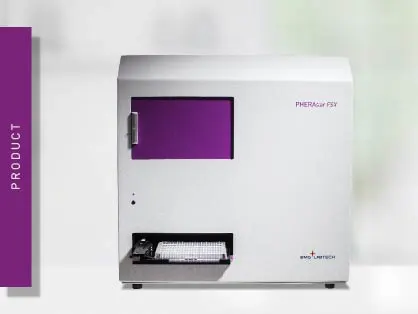
PHERAstar FSX
Powerful and most sensitive HTS plate reader
All BMG LABTECH microplate readers are equipped with both shaking and incubation, features that allow users to mix the well content and easily measure samples at elevated temperatures.
The incubator controls air temperature in the measurement chamber from near room temperature up to 45 °C. An optional extended incubation up to 60 or 65 °C is also available on several readers. Temperature-regulated heating plates are present above and below the entire plate movement area. This provides a uniform incubation for each well in every plate format and creates a more stable temperature-buffered area when microplates are inserted or when reagents are added. The upper heating plate of the incubation chamber operates at + 0.5 °C than the lower plate to prevent condensation build-up on the lid or sealer.
Incubation enables the accurate measurement of enzyme kinetics, cellular assays, apoptosis assays, and heat-shock responses. Users can also increase temperature at regular time intervals so that temperature-sensitive reactions can be carried out entirely within the reader. With the PHERAstar FSX with AAS system, it is even possible to cool the incubation chamber to any temperature between 18 and 45°C. In this application note, the AAS system’s ability to maintain a stable temperature, reduce evaporation and the cool-down time from high to low temperatures is demonstrated.
Mixing solvents (e.g. after injection) is probably the most common application for shaking. Nevertheless, there are many other assays where shaking is essential. For example, maintaining aerobic conditions in cell culture by permanent shaking to increase the oxygen uptake, or in prion-related assays like the RT-QuIC assay which applies intensive shaking with up to 1100 rpm.
BMG LABTECH microplate readers are equipped with multi-mode shaking with definable intensity, duration, and direction of motion. Users can select orbital, double-orbital, or linear shaking, adjust the shaking radius, and vary displacement based upon well size and fluid volume.
Shaking can be programmed to occur before or after kinetic measurement cycles, or only after an injection cycle has been completed. For assays that require high uniformity, shaking can take place immediately following reagent injection into a well.
Choosing the right combination of shaking mode, shaking frequency and microplate is essential to obtaining reliable results. For instance, square well formats lead to a better mixing efficiency than round well formats since they act like baffles.
Well dimension and filling volume also play an important role. Shaking a 6-well or a 1536-well microplate with half-filled wells at 100 rpm will have a significantly different effect.
Moreover, surface tension has to be considered. The higher it is, the higher the shaking frequency must be to ensure thorough mixing. Aqueous solutions typically have rather high surface tension and thus typically require higher shaking frequencies.
Finally, the shaking settings that are used depending on the application. For example, breaking particles by shear forces will require higher shaking frequencies, while homogenization will typically be done at lower shaking frequencies.
Powerful and most sensitive HTS plate reader
Most flexible Plate Reader for Assay Development
Flexible microplate reader with simplified workflows
Upgradeable single and multi-mode microplate reader series
Absorbance plate reader with cuvette port
Microplate nephelometer for light-scattering and turbidity measurements